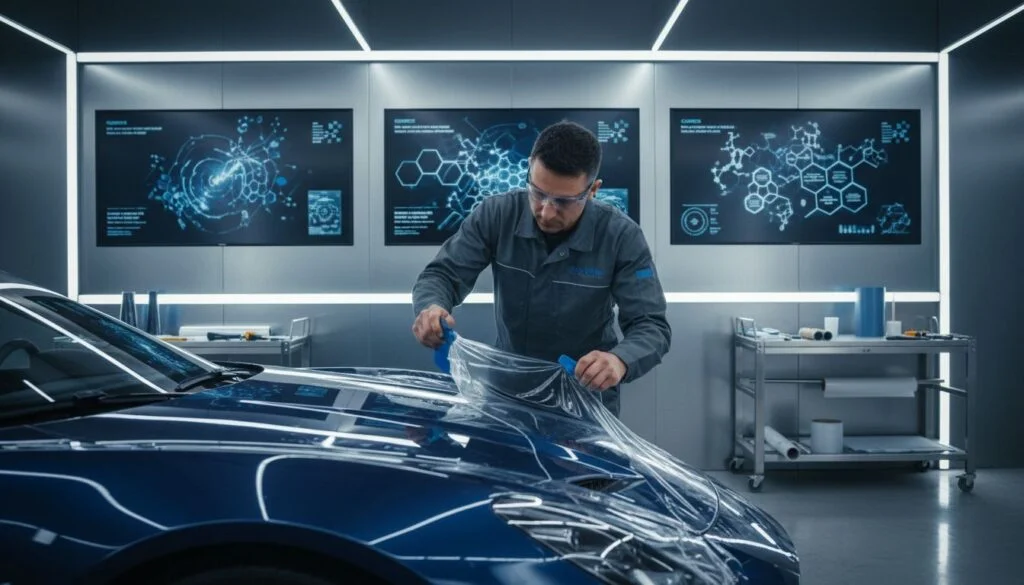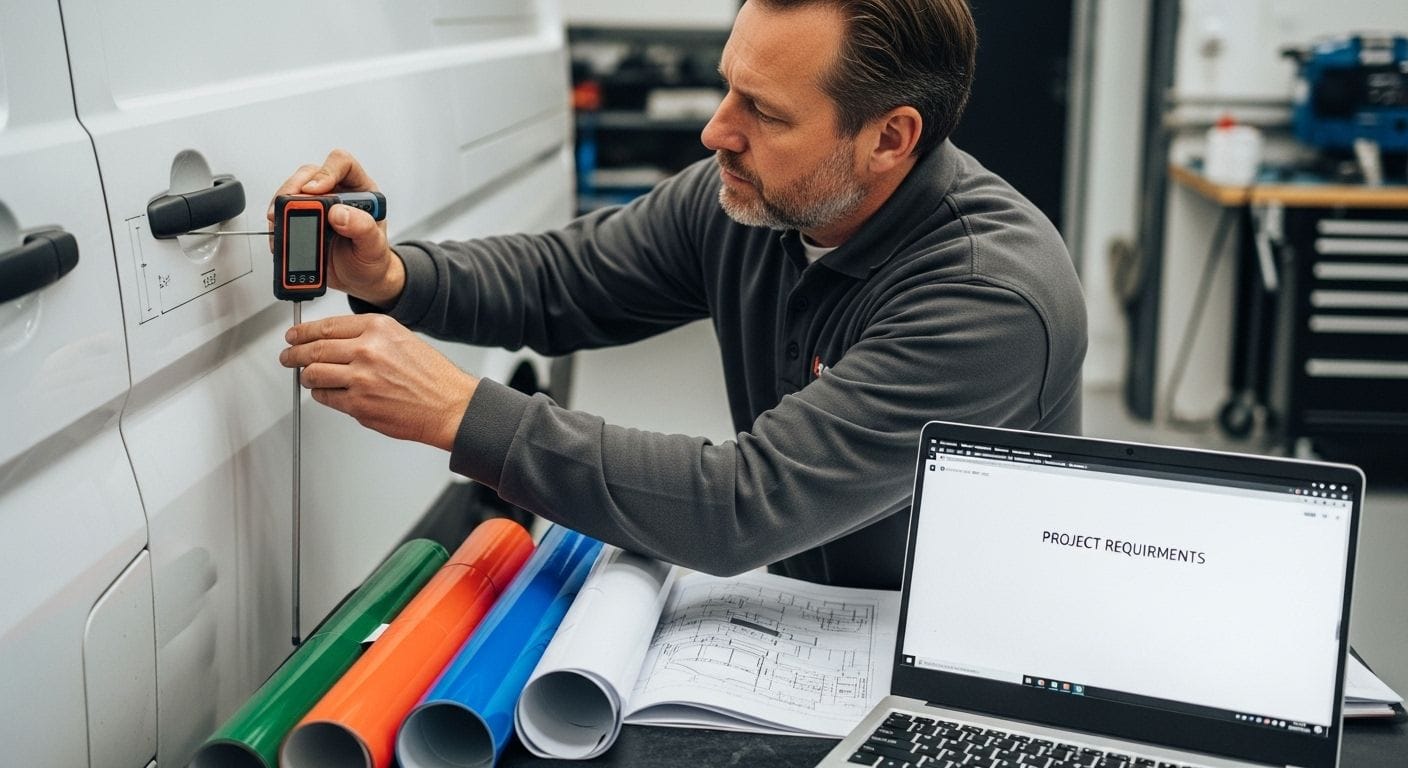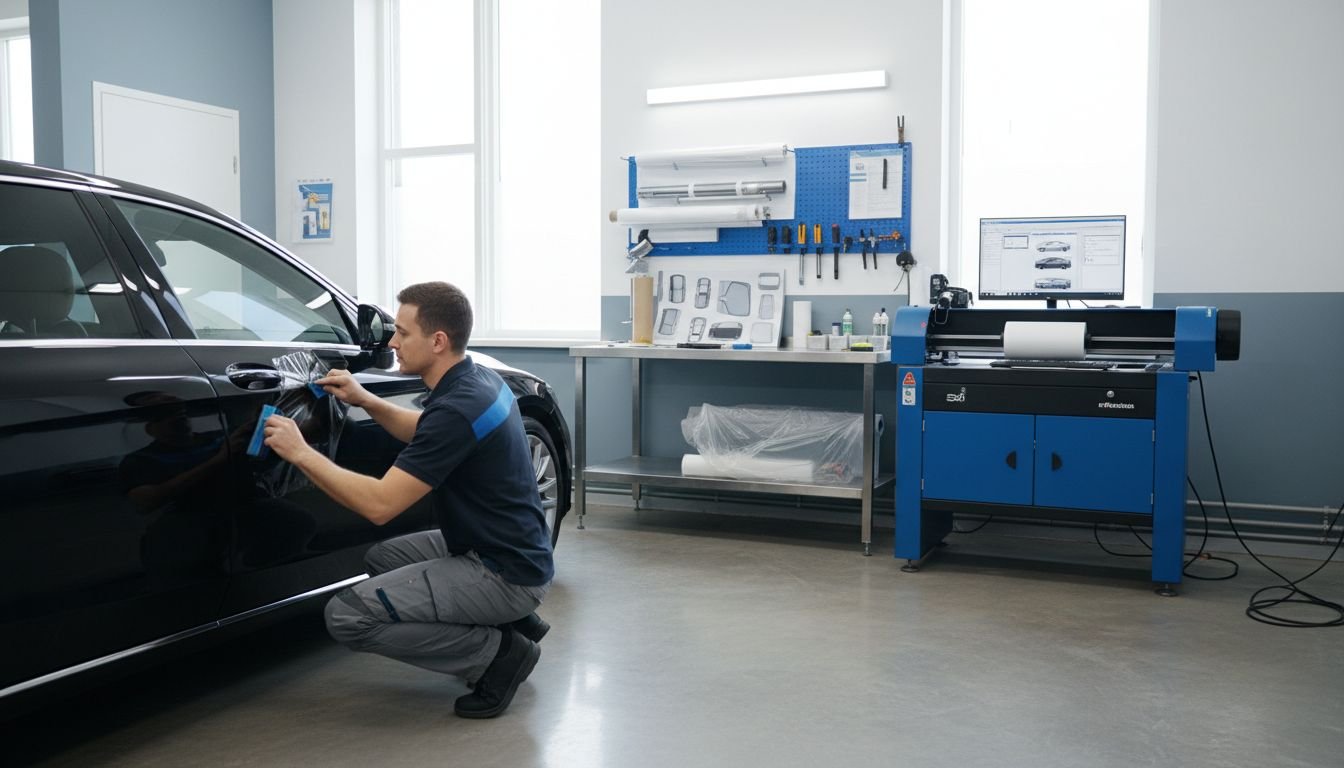
Modern vehicles face a relentless assault from road debris, UV rays, and harsh weather, leading to visible damage that frustrates drivers and professionals alike. With over 80 percent of luxury vehicle owners turning to protective films, the demand for advanced solutions is higher than ever. Thermoplastic polyurethane paint protection film answers this need with remarkable self-healing, clarity, and resilience that set a new standard in automotive care. Discover how this cutting-edge material transforms surface protection for installers and vehicle owners.
Table of Contents
- Defining TPU PPF And Its Material Role
- Recent Innovations In TPU Polymer Chemistry
- Enhanced Durability And Performance Features
- Surface Coating Breakthroughs For TPU PPF
- Real-World Benefits For PPF Installers
Key Takeaways
| Point | Details |
|---|---|
| Advanced Protection | TPU PPF provides superior flexibility, impact resistance, and self-healing capabilities, making it highly effective for vehicle surface protection. |
| Innovative Material Science | Recent advancements in TPU chemistry, including AI-driven molecular design and graphene incorporation, enhance the durability and thermal performance of PPF. |
| Surface Coating Enhancements | Breakthrough technologies like nano-engineered coatings improve hydrophobicity and self-cleaning properties, significantly increasing the film’s effectiveness. |
| Business Advantages for Installers | TPU PPF offers installers the opportunity for higher service pricing, reduced complaints, and enhanced customer satisfaction, leading to a stronger professional reputation. |
Defining TPU PPF and Its Material Role
Thermoplastic polyurethane (TPU) paint protection film (PPF) represents a groundbreaking material technology designed to safeguard vehicle surfaces against environmental damage. Wikipedia confirms that PPF is a specialized thermoplastic urethane film applied to painted surfaces to protect against stone chips, bug splatters, and minor abrasions.
At its core, TPU PPF functions as a sophisticated protective barrier with remarkable material properties. Unlike traditional protective coatings, this advanced film offers exceptional flexibility and durability. The thermoplastic polyurethane composition allows the material to self-heal minor scratches, maintain transparency, and conform seamlessly to complex vehicle contours. Professional installers appreciate TPU PPF’s ability to absorb impact energy while preserving the underlying paint’s pristine condition.
The material’s unique characteristics make it versatile across multiple applications. While initially developed for automotive use, TPU PPF has expanded to protect surfaces on airplanes, recreational vehicles, motorcycles, and even electronic devices. Learn more about PPF applications in our comprehensive guide on how PPF works.
Key material properties of TPU PPF include:
- High impact resistance
- Self-healing capabilities
- UV radiation protection
- Exceptional transparency
- Chemical and stain resistance
- Minimal thickness (typically 140-200 microns)
For professional installers and automotive care specialists, understanding the material science behind TPU PPF is crucial. Its engineered molecular structure provides superior protection while maintaining the vehicle’s aesthetic appeal, representing a significant advancement in surface protection technology.

Recent Innovations in TPU Polymer Chemistry
The landscape of thermoplastic polyurethane (TPU) polymer chemistry is experiencing remarkable transformations driven by advanced computational and material science techniques. arXiv research demonstrates an groundbreaking AI-assisted workflow for designing high thermal conductivity polymers, using deep neural network models to predict and optimize polymer characteristics with unprecedented precision.
One significant breakthrough involves composite material development. arXiv highlights a novel approach where researchers synthesized a 3D printing filament combining titanium nitride (TiN) and thermoplastic polyurethane, creating a material with superior photothermal performance. This innovation opens potential applications in specialized domains like de-icing technologies and infrared labeling, showcasing TPU’s remarkable adaptability.
The emerging field of polymer chemistry now leverages artificial intelligence and machine learning to accelerate material innovation. By constructing computational models that can predict thermal conductivity and molecular behavior, scientists can design sequence-ordered polymers with enhanced properties more efficiently than traditional experimental methods. Learn more about advanced PPF technologies in our professional’s buying guide.
Key emerging trends in TPU polymer chemistry include:
- AI-driven molecular design
- Computational predictive modeling
- Hybrid composite material development
- Enhanced thermal performance optimization
- Multifunctional polymer engineering
These advancements represent a paradigm shift in material science, enabling researchers and manufacturers to create increasingly sophisticated TPU polymers with tailored characteristics for specialized applications in automotive, electronics, and protective technologies.
Enhanced Durability and Performance Features
The evolution of thermoplastic polyurethane (TPU) paint protection films has reached unprecedented levels of performance, driven by innovative material engineering techniques. arXiv research reveals a groundbreaking development in TPU technology: a sophisticated double-layer structure incorporating graphene-enhanced thermoplastic polyurethane (G-TPU), which demonstrates remarkable anisotropic thermal conductivity and superior mechanical properties.
This advanced material configuration offers unprecedented durability for automotive protection applications. The graphene-enhanced TPU structure exhibits exceptional thermal management capabilities, with high in-plane thermal conductivity and strategically controlled through-plane thermal characteristics. Professional installers can now leverage these innovations to provide clients with PPF solutions that withstand extreme environmental conditions while maintaining superior protective qualities. Learn more about paint protection film benefits for auto professionals.
The mechanical properties of these next-generation TPU films represent a significant leap forward in protective technology. By integrating advanced nanomaterials like graphene, manufacturers can engineer films with enhanced:
- Impact resistance
- Thermal stability
- Molecular durability
- Environmental adaptability
- Self-healing capabilities
Professional installers and automotive care specialists can now access paint protection solutions that offer unprecedented performance. These advanced TPU films not only protect vehicle surfaces but also provide intelligent, responsive protection that adapts to varying environmental challenges, marking a transformative moment in material science for automotive surface protection.

Surface Coating Breakthroughs for TPU PPF
The frontier of thermoplastic polyurethane (TPU) paint protection film surface coating technologies represents a quantum leap in automotive surface protection engineering. Modern advancements have transformed TPU PPF from a simple protective layer to an intelligent, adaptive shield that responds dynamically to environmental challenges and mechanical stresses.
Professional installers now have access to surface coating technologies that dramatically enhance the fundamental properties of TPU PPF. These breakthrough coatings introduce nano-engineered surface treatments that provide extraordinary benefits such as enhanced hydrophobicity, self-cleaning capabilities, and superior chemical resistance. Learn more about professional PPF comparisons in our detailed guide.
Key innovations in surface coating technologies for TPU PPF include:
- Nano-ceramic infusion techniques
- Hydrophobic molecular bonding
- Advanced UV resistance treatments
- Microscopic self-healing mechanisms
- Anti-oxidation surface modifications
These cutting-edge surface coating breakthroughs represent more than incremental improvements. They signal a fundamental reimagining of how protective films interact with vehicle surfaces, offering professional installers unprecedented tools to deliver superior protection, aesthetic enhancement, and long-term durability for automotive surfaces.
Real-World Benefits for PPF Installers
Thermoplastic polyurethane (TPU) paint protection film represents a game-changing technology for professional automotive protection specialists. TPU Huanlong confirms that TPU film is the core substrate for premium automotive protection, offering superior flexibility, optical clarity, self-healing capabilities, and exceptional weather resistance that directly translates to tangible business advantages.
Professional installers can leverage these advanced material properties to differentiate their services and provide clients with unprecedented protection. The inherent characteristics of TPU PPF enable installers to offer solutions that protect vehicle surfaces from scratches, stone chips, UV exposure, and environmental damage while maintaining the original paint’s aesthetic quality. Learn strategies for building a successful PPF business.
Key real-world benefits for PPF installers include:
- Reduced customer complaint rates
- Higher service pricing potential
- Extended warranty opportunities
- Enhanced professional reputation
- Minimal material waste during installation
- Faster installation processes
- Greater customer satisfaction and retention
By understanding and communicating the advanced material science behind TPU PPF, professional installers can position themselves as cutting-edge service providers. These innovative films not only protect vehicles but also represent a sophisticated solution that demonstrates technical expertise and commitment to quality automotive care.
Elevate Your TPU PPF Installation with Precision Cutting Solutions
Understanding the advanced material science behind thermoplastic polyurethane paint protection films unlocks new possibilities for professional installers eager to deliver the highest quality results. The article highlights challenges such as maintaining the intricate flexibility, self-healing properties, and perfect optical clarity of TPU PPF—factors that demand precise cutting and application to fully harness these innovative material benefits.
At aeoncutsw.com, our PPF software – AEONCUT PPF Pre-cut Cutting software is designed specifically to meet these demands. By providing access to extensive pattern libraries, AI-driven auto-nesting, and cloud-based updates, we empower installers to achieve exact cuts that complement TPU PPF’s advanced performance features. This precision reduces waste, accelerates installation time, and preserves the integrity of cutting-edge TPU films. Explore the seamless integration of your expertise with state-of-the-art digital solutions in our Paint Protection Film – AEONCUT PPF Pre-cut Cutting software section and start delivering unparalleled protection that matches the sophistication of modern TPU materials.
Take control of your PPF business today and witness how combining expert knowledge with advanced cutting software delivers superior customer satisfaction and long-term success.

Boost your installations now by visiting aeoncutsw.com and unlocking software tools that respect the precision TPU PPF demands. Don’t let material advances outpace your workflow—equip yourself with AEONCUT and lead the future of paint protection film installation.
Frequently Asked Questions
What is TPU PPF and how does it protect vehicle surfaces?
TPU PPF, or thermoplastic polyurethane paint protection film, is a specialized film that acts as a protective barrier for vehicle paint. It guards against stone chips, bug splatters, and minor abrasions while maintaining transparency and flexibility to conform to complex shapes.
How does the self-healing capability of TPU PPF work?
The self-healing capability of TPU PPF allows the film to recover from minor scratches and abrasions when exposed to heat. This ensures that the surface remains smooth and visually appealing over time, providing long-lasting protection.
What are the benefits of graphene-enhanced TPU films?
Graphene-enhanced TPU films offer several advantages, such as improved thermal management, increased durability, better impact resistance, and enhanced self-healing properties. These advancements ensure superior protection for automotive surfaces in extreme conditions.
How do nano-engineered surface coatings improve TPU PPF performance?
Nano-engineered surface coatings enhance TPU PPF by providing features like improved hydrophobicity, self-cleaning capabilities, and superior resistance to chemicals and UV damage. These innovations enable the film to interact more effectively with environmental factors, offering better long-term protection.
Recommended
- How Does PPF Work? Guide for Car Care Pros 2025 – AEONCUT PPF Pre-cut Cutting software
- Top PPF Brands in 2025: A Professional’s Buying Guide – AEONCUT PPF Pre-cut Cutting software
- Top PPF Brands in 2025: A Professional’s Buying Guide – AEONCUT PPF Pre-cut Cutting software
- Top PPF Brands in 2025: A Professional’s Buying Guide – AEONCUT PPF Pre-cut Cutting software



